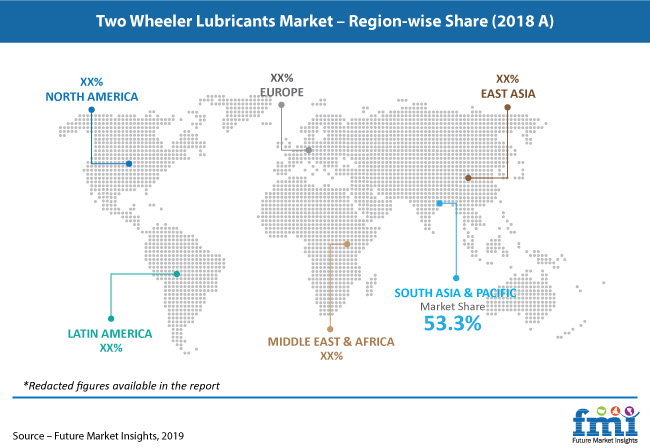Future Market Insights (FMI), in its new publication, offers actionable insights on future prospects of the ‘Two-Wheeler Lubricants Market’ for the period between 2019 and 2029. As per the study, the global sales of two-wheeler lubricants reached ~2,300 KT, equaling revenues worth US$ 13.7 Bn in 2018.
The emergence of two-wheelers as a primary mode of transportation in developing countries has been weighing on the same scale as the rapid adoption of two-wheeler lubricants. However, growing prominence of electric vehicles, in the view of increasing consumer interest towards a carbon-free future via zero-emission transport, may pose as a potential threat to the market growth.
To Get Sample Copy of Report visit @ https://www.futuremarketinsights.com/reports/sample/rep-gb-10121

Meeting ever-tightening VOC emission limits while maintaining the durability of the vehicle component has been a hard balance to strike for the two-wheeler lubricants market players. FMI study finds that manufacturers are heavily investing in the development of additive technology that not only ensures the delivery of required fuel economy but also maintains high friction, hardware protection, and durability.
Synthetic Oil to Emerge as the Preferred Option
The study opines that two-wheeler lubricants market is likely to record a volume CAGR of 4% during the forecast period. While mineral oils continue to account for relatively high sales, manufacturers are focusing on increasing the production of synthetic and semi-synthetic oils to capitalize on growing demand for premium synthetic two-wheeler lubricants. Considering the incorporation of advanced engine technologies in modern vehicles along with greater consumer awareness regarding the performance advantages of synthetic lubricants, manufacturers are specifically focused on non-mineral oils.
Moreover, a shift towards premiumization of products for increased warranty and extended oil drain interval is likely to necessitate the increased adoption of synthetic content in two-wheeler lubricants. Further, to address growing greener fuels and sustainable requirements, a number of market players are targeted towards the development of effective bio-based lubricants.
According to the study, the use of two-wheeler lubricants in motorcycles, especially mopeds and standard varieties, has been on a higher side as compared to scooters. With the emergence of next-gen motorcycles that facilitate efficient clutch operation and require multi-functional lubricants, manufactures are focusing on product innovations and new developments to deliver optimal ride experience.
The study finds that aftermarket sales of two-wheeler lubricants account for relatively high share than OEM sales, and are expected to record a volume Y-o-Y growth of 4.3% in 2019 over 2018. The need for regular and periodic servicing for two-wheelers for their smooth functioning and durability, even in poor road infrastructure, will continue to drive the aftermarket sales of two-wheeler lubricants.
As per the study, developing countries in Asia Pacific, Latin America, and Africa continue to offer greater opportunities due to increased mobility and rising disposable income in these regions, which are directly correlated to the successful penetration of two-wheelers. Although North America and Europe two-wheeler lubricants markets are not likely to show dramatic growth in terms of volume, FMI study finds that penetration of synthetic or premium lubricants in these regions will be high in the future.
According to the study, one of the key growth drivers of the two-wheeler lubricants market is lack of public transportation in rural areas which has led to a surge in the adoption of two-wheelers. Although motorcycle sales have shown a sharp decline in developed nations over the years, rising interest in motorcycle riding for recreational purposes have contributed to the soaring need for two-wheeler lubricants in these nations.
The business asset highlights the competitive landscape in two-wheelers lubricants market by assessing business development strategies of key players. The market shows a fair level of consolidation, with leading stakeholders placing their strategic focus on product innovations and firmer geographical footprint.
Key Segment
By Product
- Synthetic Oils
- Semi-Synthetic Oils
- Mineral Oils
- Bio-Based Lubricants
- Greases
By Two Wheeler Type
- Motorcycle
- Standard
- Cruiser
- Sports
- Mopeds
- Scooter
- Standard
- Maxi
- Enclosed
- Three-Wheeled
By Application
- Engine Oil
- Suspension Oil
- Break Oil
- Chain Oil
By Sales Channel
- OEM
- Aftermarket
By Region
- North America
- Latin America
- Europe
- South Asia
- East Asia
- Oceania
- Middle East and Africa
